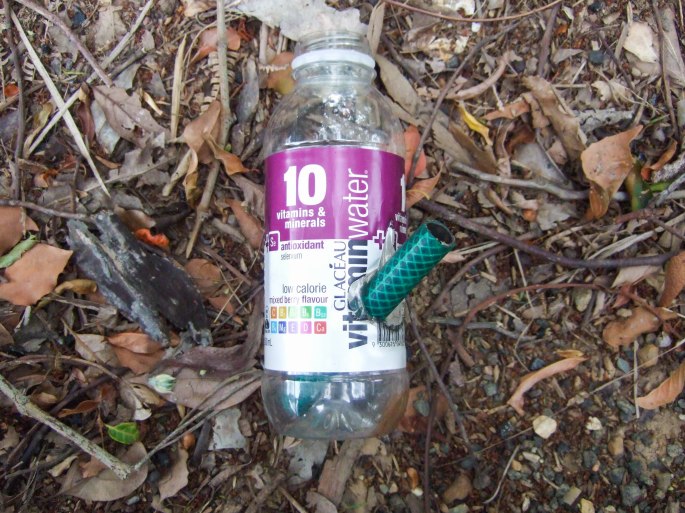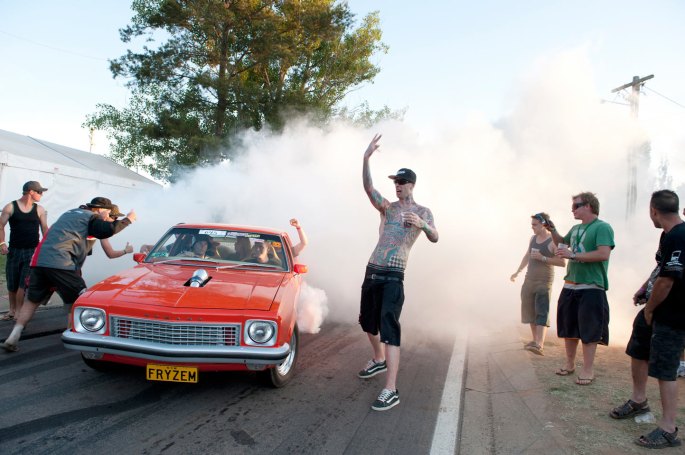I live in arguably one of the most beautiful areas of Australia: the Northern Rivers of New South Wales. Just 6km to the border of Queensland, in the lush green hinterland caldera surrounding Wollumbin (Mt Warning). Sacred to the aborigines, the tip of this 23 million year old volcano is the first place in Australia to be illuminated by the sun’s rays each morning. Because of the beauty of the place, I feel even more confronted when I come across rubbish on the side of the road. It’s out-of-placeness is so acute, that I cannot help wonder who would throw it out of their car window and why?
Though this is not a topic that immediately seems relevant to a visual culture blog, the items of rubbish are visual. They are visual in their effect on the landscape, and they are visual because they are pieces of packaging that have been designed by graphic designers. The issue is also one that public sector campaigns, community organisations, and not-for profit organisations are trying to tackle through media campaigns and billboards. As such, the way the problem is approached through visual campaigns is influenced by our understanding of the causes of littering behaviour.

Litterbug Fieldwork
When going for walks or runs with my daughter in her stroller we help each other spot the rubbish and pick it up to throw in our own bin. We sometimes sing a Playschool song that goes “Pick up the litter at your feet, pick up the litter in the street. Don’t just throw it away. You don’t want to be a litterbug…”. After many such trips with always the same types of rubbish, I started to wonder what the correlation is between the types of people who throw litter out of their car, and the content of the packaging they are throwing.
The area surrounding Murwillumbah is a funny mix of all sorts of people; there are the farming families who have been here for generations; there are those from lower socio-economic backgrounds; there are the alternatives and hippies; there are those of aboriginal decent, there are the Hare Krishnas, there are the rich who have moved from the cities to find their private piece of paradise; there are the hipsters/artists/intellectuals; and there are the average working families being out-priced from the Gold Coast and Byron Bay. Furthermore, there are the celebrities. At the end of our neighbouring road the reality television game show “I’m a celebrity…Get me out of here!” is filmed. In the show B-grade British or German celebrities are subjected to all kinds of wilderness horrors. The supposedly remote “jungle” setting of the show is at the end of a residential road, 10 minutes from town.
Back to the rubbish. From my non-scientific field work, these are the six types of packaging I have found again and again, and therefore these are what I would classify as the top six habits of a litterbug:
1. They eat junk food. Usually McDonald’s or KFC.
2. They eat unhealthy snacks. Often chocolate bars and potato chips.
3. They drink sugary drinks. Soft drinks, chocolate milks, milk shakes.
4. They drink energy drinks, or eat those energy gels you get in little packets.
5. They drink alcohol. Often beer or ready mixed alcoholic beverages.
6. They smoke cigarettes.
(7). They smoke marijuana. I have only found one bit of evidence for this, so I cannot make any firm conclusions. I first thought this was just a vitamin drink bottle, until I turned it over and discovered it was a home-made water bong (for smoking weed).
1. Junk Food
2. Junk snacks
3. Sugary drinks
4. Energy drinks & gels
5. Alcohol
6. Cigarettes
(7). Marijuana

Now from these habits one could easily form an opinion about the type of person who would carelessly throw something out of their car: (1) young; (2) male, (3) racing along in a bombed out car with some mates (probably doing burnouts), (4) a bunch of inconsiderate hoons (or as Australians would call them bogans). The scene is set: They’re having a few drinks, smoking a ciggy, and munching a burger or some fried chicken with loud music blaring. Or they are hung over, downing a can of coke and an energy drink, while snacking on Mars bars and Magnums. They are loud, they are obnoxious, and they just don’t care. Puzzle solved. Or is it… Stereotypes are usually over simplistic, and complexities far more interesting and confronting are frequently behind the social constructs of our culture.

Investigating Litterbug Habits
One day on my walk I came across this rubbish:
It was so out of the ordinary, that it took me by surprise. These were wrappers of so called “healthy” drinks/foods. Did it prove my theory of the 6 habits wrong? A little further down the road I found one of my kids’ doodles among the items, and realised it was my rubbish! I was a litterbug! So much for being on my holier-than-thou trip. It turned out these items had fallen out of our bin, when it was stolen by a neighbour. It made me realise that while I might think myself beyond littering, anyone can be a litterbug, depending on what is going on in their life.
What if rather than being about a particular type of person, the habits of a litterbug is about a momentary (or systemic) disregard for health. There is a common trait in the 6 (or 7) types of rubbish: They are all associated with consuming something which is considered unhealthy, which is fast and convenient, and which gives either stimulation or an energy hit. There seems to be a correlation between disrespect for the body and disrespect for nature. A need for fast and convenient access to energy and stimulation (from sugar, fat, empty carbs, alcohol, caffeine or nicotine) reflecting an impatience symptomatic of contemporary life in general. When we expect instant gratification the need for instant rubbish disposal follows. In that moment we have lost touch with our body and its real needs, and in that moment we have also lost touch with a sense of belonging to nature.
In his book Changeology, Les Robinson explores how people’s beliefs are often not in line with their actions. For instance research shows that most people who litter do in fact care about the environment, and what people think about them; however, they are unable to match their beliefs to their actions1. In the book Robinson sites a research project, which focuses on littering in Australia. The following is a quote from the report:
One of the most significant findings was that a simple two way split between ‘people who litter’ and ‘people who use bins’ is not the best way to characterise people’s disposal behaviour. In many cases, there appear to be greater differences between different sorts of littering and binning behaviour than there are between some people who litter and those who use bins.2
The report shows that it is ineffective to classify people into categories of litterers and non-litterers. Any of us can end up littering, and often people do so unconsciously. Stereotypes are not reflected in the findings, as men and women seem to litter equally, and though they litter somewhat more than other ages when in a group, people between the age of 15 and 24 litter less than other adults when they are on their own.
Perhaps whether or not someone litters is dependant on how they feel in that exact moment, and how they feel about the item they are consuming and themselves. Certainly the majority of the rubbish I found could have come from drunken hoons, showing off their rebellious disregard for authority to each other. But it could also have come from a dieting nurse, who feels disgusted with herself for eating another chocolate bar, and therefore throws the wrapper out the window. Or it could come from a lawyer who doesn’t want his wife to know he has not given up smoking, and wants to get rid of the evidence. It could come from an exhausted parent, who has finished off a burger and a thick shake on the go, and hasn’t got the mental energy to deal with the rubbish. It could be from a high school teacher who is drinking in secret driving home from work, and feels ashamed. It could come from one of the many lycra cyclists who hasn’t got a spare pocket for her energy gel wrapper. Or perhaps from a B-grade celebrity who just needs a Coca Cola pick-me-up after a rough night sleeping in a snake pit and eating hand sized spiders. Whatever the mental and emotional state in that decisive moment will dictate whether the window is rolled down and the rubbish tossed, or whether there is a capacity and willingness to hold on to the rubbish and dispose of it correctly.
My suggestion is that the nature of these 6 habits (eating junk food and snacks, drinking sugar, alcohol and caffeine, and smoking cigarettes), render them prone to induce rubbish tossing behaviour, because generally these habits make people feel bad about themselves, or ashamed, or apathetic. Those who toss packaging from these item groups, may at other times dispose perfectly of other packaging. As the research shows, the very same people were observed sometimes littering, and at other times putting rubbish in the bin3. Whether people were in a group or not also affected their likelihood to litter (young people were more likely to litter in a group, while older people were less likely to). So littering behaviour is connected to the type of rubbish, and to the social setting at a given moment4.
Tossers and behaviour change.
With this in mind, what might image makers, social marketeers, and packaging designers do differently to curb the spread of litter? In Australia government campaigns have focused on shaming those who litter. For instance, the NSW Environment Protection Authority have created a campaign which uses billboards, TV and radio ads. The message is “Hey Tosser! Put it in the bin”. In the campaign a number of people littering are shamed by appalled bystanders who call them “tossers” (in British, New Zealand and Australian slang a “tosser” means a “jerk” or a “wanker”). The bystanders are encouraged to report a “tosser”, which can be done online.
Bottle litter:
Takeaway litter:
Cigarette buds:
Shaming is something that is often used in public sector campaigns. However, research warns that the use of shame in campaigns is likely to be ineffective, or even counter productive5. Shaming can lead to anger and feelings of isolation, which are usually not emotions that encourage behaviour change. When shaming occurs in relation to littering of items that already potentially make people feel ashamed of themselves (e.g. smoking, drinking, unhealthy eating) the shaming may have double the negative impact. Viewed through the lens of behaviour change research the “Hey Tosser!” campaign ticks all the wrong boxes, creating a “them” (the tossers) and “us” (the good citizens) scenario. As Robson writes in Changeology:
An aim of this book is to show that change need not be an attack on people’s badness. It will always be better to treat people with kindness and respect, recognising their need to remain safe, be in control of their lives, and feel good about themselves… Rather than trying to change people, it will always be better to help people change themselves.6
So if we can’t shame people out of littering, what can be done? Firstly, looking at the 6 habits above, it might be useful for creators of anti-littering campaigns and information initiatives; for the producers of goods; and for packaging designers to consider the types of items that are littered. That means a responsibility lies with those who produce and design packaging for fast food, sugary or fatty snacks, alcohol, energy drinks, soft drinks and other sugary drinks, and cigarettes, because these are the items often littered (of course more “scientific” field work would be needed). Chances are that health food packaging will be disposed of appropriately, because the person feels better about consuming it. So if we know a cigarette package, a chocolate bar wrapper, or a beer can is more likely to end up on the side of the road, how might it be designed differently so that it degrades? That would be one challenge to put to packaging designers.
A second challenge would be to create more sustainable social change through positive means. Robson7 suggests 6 steps that can successfully create change:
- Positive buzz (when people share optimistic stories about change)
- An offer of hope (when people make the connection between a novel action and their own hopes and frustrations)
- An enabling environment (when people’s environments make new behaviours easy to do and sustain)
- A sticky solution (when behaviours are reinvented to better fit people’s lives)
- Expanded comfort zones (when people are helped to reduce their fears)
- The right inviter (when inspiring, trusted peers invite action)
How these 6 steps could be implemented would depend on a number of different factors such as where the littering is occurring, and the social and cultural background of those in the area. The solutions would be unique for each situation. In each scenario it would be important to recognise that it is not necessarily a certain type of person who litters. Rather, it is worth considering that the type of rubbish littered tells us something about the emotional state of those who litter in that moment, their feelings toward themselves and their bodies in that moment, and in extension their lack of concern for the environment in that moment.
Perhaps the imagined dieting nurse who tossed the chocolate wrapper always composts her vegetable scraps. Perhaps the lawyer who chucked the cigarette package always recycles his milk bottles. Perhaps the exhausted parent at other times disposes correctly of the kids’ muesli bar wrappers. Perhaps the high school teacher who threw the beer can always recycles his disposable water bottles. Perhaps the cyclist usually picks up litter when she walks the dog. Perhaps the celebrity would never normally drink a can of Coke. And perhaps the reckless hoons who tossed the homemade bong, always feed their scraps to their worm farm at home. Rather than being permanent “tossers”, they momentarily became litterbugs.
Footnotes
- Les Robinson, Changeology: How to Enable Groups, Communities, and Societies to do Things They’ve Never Done Before (Melbourne: Scribe Publications, 2012), 16.
- Rob Curnow, Peter Streker, and Emma Williams, Understanding Littering Behaviour in Australia (Beverage Industry Environment Council, 1997), 8.
- Ibid, 8.
- Ibid, 7.
- e.g. Roger Bennett, “Shame, Guilt & Responses to Non-profit & Public Sector Ads”, International Journal of Advertising, 17, no. 4 (1998): 483-499; Linda Brennan and Wayne Binney, “Fear, Guilt, and Shame Appeals in Social Marketing”, Journal of Business Research 63 (2010): 140–146.
- Robinson, Changeology, 48-49.
- Ibid, 49.


























